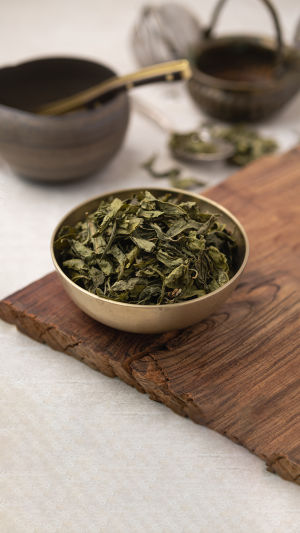Tea, a beloved beverage, gracefully unfolds into six distinct categories, each boasting its own unique charm and character: green tea, black tea, white tea, yellow tea, dark tea (post-fermented tea), and oolong tea.
Let's embark on a journey through the basic production processes that define each of these tea varieties.
<b>1. Green Tea:</b> Fresh leaves undergo a sequence of de-enzyming, twisting (shaping), and drying, making green tea the world's foremost in color variety. The process choices—fried, baked, steamed, or sun-dried—give rise to diverse shapes such as strip, needle, flat, and ball-shaped. Green tea, with its clear, fragrant, and mellow broth, emphasizes purity and elegance.
<b>2. Yellow Tea:</b> Yellow tea is lightly fermented and follows a similar process to green tea but is distinct for its "yellow leaves and yellow soup." The tender buds and young leaves are used to create its delicate flavor and as they are not dried sufficiently or promptly after de-enzyming, these leaves take on a golden brightness.
<b>3. Black Tea:</b> Characterized by full fermentation, black tea undergoes de-enzyming, twisting, stacking, and drying processes. The final appearance is black, hence the name. Using coarse old tea leaves, black tea offers a mature, fragrant, and thick flavor, distinguishing itself from its green tea counterpart.
<b>4. White Tea:</b> Known for its white appearance, white tea skips frying or kneading. Tender, hairy tea leaves undergo a gentle drying process, preserving the white hairs, resulting in a mildly fermented tea. The buds, rich with white hairs, lend the tea a fresh, fragrant, and sweet taste.
<b>5. Oolong Tea:</b> Bridging the gap between black and green tea, oolong tea is a semi-fermented variety. With withering, bruising, frying, and twisting in its production, oolong tea exhibits both the freshness of green tea and the sweetness of black tea. This intricate, time-consuming process earns oolong tea the moniker "Gongfu tea," known for its green and gold appearance.
<b>6. Dark Tea (Post-fermented Tea):</b> Falling into the fully fermented tea category, dark tea is crafted from tea tree buds and leaves through withering, kneading, fermentation, and drying. The dry tea's rich color translates into a red-toned broth upon brewing. Renowned for its aromatic, strong flavor, dark tea offers a thick, sweet taste with a hint of cinnamon or pine smoke aroma.
In the world of tea, these diverse categories showcase the artistry and skill of tea production, with each cup telling a tale of tradition, innovation, and the delicate nuances of nature.
Tea, a cultural tapestry woven with flavor and tradition, unravels into six enchanting categories, each painting a distinct portrait of taste and craftsmanship. <b>Green tea</b>, a verdant masterpiece, undergoes meticulous processes, from de-enzyming to shaping, embodying purity. <b>Yellow tea</b>, born from nuanced drying, unveils a mellow symphony of yellow leaves and golden soup.
<b>Black tea</b>, a fully fermented treasure, dances through de-enzyming, twisting, stacking, and drying, delivering a mature, fragrant allure. <b>White tea</b>, a delicate creation untouched by frying or kneading, reveals a mildly fermented beauty with buds adorned in white splendor.
<b>Oolong tea</b>, the artisanal bridge between green and black, emerges as a semi-fermented marvel, exuding the freshness of green tea and the sweetness of black.
In this symphony of flavors, each tea variety, be it green, yellow, black, white, oolong, or dark, narrates a unique tale, inviting connoisseurs on a sensory voyage through the world of tea.





